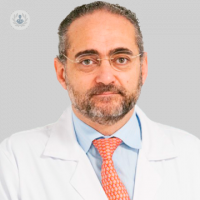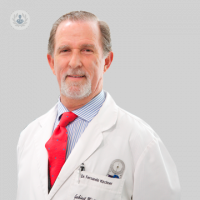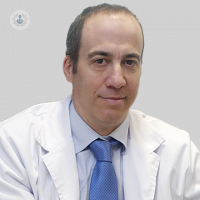Cervical disc herniation
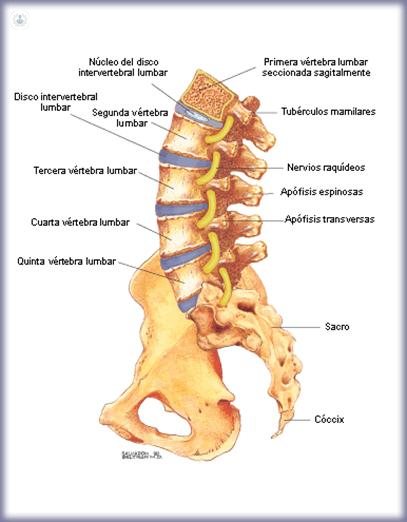

What are low back pain and sciatica?
By Dr. Javier Cobo Soriano
2024-04-28
The lumbar spine consists of 5 vertebrae and 5 discs are numbered from top to bottom. Dr. Cobo Soriano explains that the intervertebral discs are located between the vertebral bodies and make the role of buffer. See more


¿Tengo una hernia de disco lumbar?
By Dra. Pilar Baños Carrasco
2024-04-28
Una hernia es una protusión que se puede producir en cualquier tejido u órgano, que se queda fuera del lugar en el que se ubican normalmente. La hernia de disco lumbar se produce en el momento en el que un disco intervertebral degenerado se rompe y su contenido sobrepasa los límites habituales. La Dra. Pilar Baños, del Instituto Clavel explica las claves para saber si padeces una hernia de disco lumbar. See more


La falsa ciática o pseudociática: un mal diagnóstico puede tener graves consecuencias
By Dr. Carlos Antonio Morales Portillo
2024-04-28
¿Sabías que 3 de cada 10 casos de dolor de tipo ciático no provienen de una hernia discal? El Dr. Morales Portillo, especialista en Unidad del Dolor y experto en técnicas mínimamente invasivas en el tratamiento de lumbalgia, ciatalgía y otras dolencias, alerta de que la hernia discal es la causa más conocida de dolor de espalda, pero no la única. See more
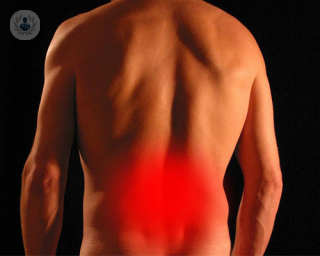

¿Qué es y por qué se produce una hernia discal?
By Juan Manuel Junco Pelayo
2024-04-28
¿Qué es una hernia discal? ¿Por qué se produce y cómo se puede tratar? El Sr. Junco Pelayo, especialista en Fisioterapia, responde a las dudas más frecuentes acerca de las hernias. See more
Experts in Cervical disc herniation
-
Dr. Luis Ley Urzaiz
Neurological SurgeryExpert in:
- Minimally invasive spine surgery
- Cervical disc herniation
- Lumbar disc herniation
- Brain Cancers
- Trigeminal Neuralgia
- Acoustic neuroma surgery
-
Dr. Pedro Mata González
Neurological SurgeryExpert in:
- Lumbar disc herniation
- Cervical disc herniation
- Canal stenosis
- Discectomy
- Minimally invasive spine surgery
- spinal fusion
-
Dr. Fernando Kirchner
Orthopaedic SurgeryExpert in:
- Knee Surgery
- Growth Factors
- Cervical disc herniation
- Lumbar disc herniation
- Back injuries
- Column osteoarthritis
-
Dr. Bartolomé Fiol Busquets
Neurological SurgeryExpert in:
- Column Tumors
- Brain Cancers
- Cervical disc herniation
- Lumbar disc herniation
- Minimally invasive spine surgery
- Discectomy
-
Dr. Josep Cabiol Belmonte
Neurological SurgeryExpert in:
- Column Tumors
- Brain Cancers
- Cervical disc herniation
- Lumbar disc herniation
- Minimally invasive spine surgery
- Discectomy
- See all

Barnaclínic +
Barnaclínic +
C/ Villarroel, 170
No existe teléfono en el centro.
By using the telephone number provided by TOP DOCTORS, you automatically agree to let us use your phone number for statistical and commercial purposes. For further information, read our Privacy Policy
Top Doctors

Hospital Doctor López Cano
Hospital Doctor López Cano
Plaza de Madrid s/n
No existe teléfono en el centro.
By using the telephone number provided by TOP DOCTORS, you automatically agree to let us use your phone number for statistical and commercial purposes. For further information, read our Privacy Policy
Top Doctors

Hospital Vithas Vigo
Hospital Vithas Vigo
Calle Vía Norte, 48
No existe teléfono en el centro.
By using the telephone number provided by TOP DOCTORS, you automatically agree to let us use your phone number for statistical and commercial purposes. For further information, read our Privacy Policy
Top Doctors
-
Barnaclínic +
C/ Villarroel, 170, BarcelonaExpert in:
- Allergy
- Andrology
- Vascular Surgery
- Skin Cancer
- Cardiology
- Cardiac Surgery
-
Hospital Doctor López Cano
Plaza de Madrid s/n, CádizExpert in:
- Allergy
- Clinical analysis
- Paediatric anaesthesia
- Vascular Surgery
- Digestive
- Cardiology
-
Hospital Vithas Vigo
Calle Vía Norte, 48, VigoExpert in:
- Digestive
- General Surgery
- Robotic Surgery
- Obstetrics and Gynecology
- Neurosurgery
- Otolaryngology
- See all
- Most viewed diseases, medical tests, and treatments
- Pain treatment
- Cancer Pain
- Chronic Pain
- Neuropathies
- Amputation
- Scheuermann's disease
- Ultrasound guided surgery
- Second medical opinion
- Biofeedback
